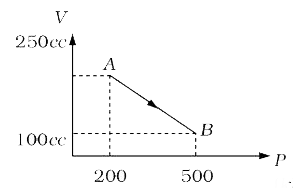A system changes from state X to Y with a change in internal energy measuring to 25 kJ mol−1, by a reversible path and returns from Y to X by an irreversible path. What will be the net change in internal energy?
25 kJ
> 25 kJ
< 25 kJ
zero
The correct Answer is:D
To solve the problem, we need to analyze the change in internal energy as the system transitions between two states, X and Y.
1. Identify the Change in Internal Energy from X to Y:
- The problem states that the change in internal energy (ΔU) when the system moves from state X to state Y is +25 kJ/mol. This means that the internal energy increases by 25 kJ/mol when going from X to Y.
2. Understand the Return from Y to X:
- The system then returns from state Y to state X. However, this return occurs via an irreversible path. Despite the path being irreversible, we need to remember that internal energy is a state function.
3. Recognize Internal Energy as a State Function:
- Since internal energy is a state function, the change in internal energy depends only on the initial and final states, not on the path taken between them. Therefore, when the system returns to state X from state Y, the change in internal energy (ΔU) will be the negative of the change when going from X to Y.
4. Calculate the Change in Internal Energy from Y to X:
- The change in internal energy when returning from Y to X is -25 kJ/mol (the negative sign indicates a decrease in internal energy).
5. Determine the Net Change in Internal Energy:
- To find the net change in internal energy for the entire process (X to Y and then Y to X), we sum the changes:
ΔUnet=ΔUXY+ΔUYX=(+25kJ/mol)+(−25kJ/mol)=0kJ/mol
6. Conclusion:
- The net change in internal energy after the complete cycle from X to Y and back to X is 0 kJ/mol.
Final Answer:
The net change in internal energy is 0 kJ/mol.
- The problem states that the change in internal energy (ΔU) when the system moves from state X to state Y is +25 kJ/mol. This means that the internal energy increases by 25 kJ/mol when going from X to Y.
- The system then returns from state Y to state X. However, this return occurs via an irreversible path. Despite the path being irreversible, we need to remember that internal energy is a state function.
- Since internal energy is a state function, the change in internal energy depends only on the initial and final states, not on the path taken between them. Therefore, when the system returns to state X from state Y, the change in internal energy (ΔU) will be the negative of the change when going from X to Y.
- The change in internal energy when returning from Y to X is -25 kJ/mol (the negative sign indicates a decrease in internal energy).
- To find the net change in internal energy for the entire process (X to Y and then Y to X), we sum the changes:
ΔUnet=ΔUXY+ΔUYX=(+25kJ/mol)+(−25kJ/mol)=0kJ/mol
- The net change in internal energy after the complete cycle from X to Y and back to X is 0 kJ/mol.
The net change in internal energy is 0 kJ/mol.
Topper's Solved these Questions
- THERMODYNAMICSBOOK - NCERT FINGERTPS ENGLISHCHAPTER - THERMODYNAMICSEXERCISE - HIGHER ORDER THINKING SKILLS
8 Videos
- THERMODYNAMICSBOOK - NCERT FINGERTPS ENGLISHCHAPTER - THERMODYNAMICSEXERCISE - NCERT EXEMPLAR PROBLEMS
11 Videos
- THE S-BLOCK ELEMENTSBOOK - NCERT FINGERTPS ENGLISHCHAPTER - THE S-BLOCK ELEMENTSEXERCISE - Assertion And Reason
15 Videos
Similar Questions
In a reversible isothermal process, the change in internal energy is :
View SolutionThe internal energy change when a system goes fromk state A to B is 40kJmol−1. If the system goes from A to B by a reversible path and returns to state A by an irreversible path, what would be the net change in internal energy?
View Solution
Knowledge Check
A system absorbs 50 kJ heat and does 20 kJ of work. What is the net change in the internal energy of the system ?
AIncrease by 30 kJBDecrease by 30 kJCIncrease by 70 kJDDecrease by 70 kJ
What happens to the change in internal energy of a gas during adiabatic expansion?
View SolutionHow will you find the change in internal energy of a system when it melts ?
View Solution160 J of work is done on the system and at the same time 100 J of heat is given out. What is the change in the internal energy ?
View Solution180 J of work is done on the system and at the same time 120 J of heat is given out. What is the change in the internal energy?
View SolutionCalculate change in internal energy if ΔH=−92.2kJ,P=40 atm and ΔV=−11.
View SolutionWhat is the change in internal energy of a system undergoing a cyclic process, at the end of a cycle ?
View SolutionA mono-atomic gas is taken along path AB as shown. Calculate change in internal energy of the gas.

View Solution
